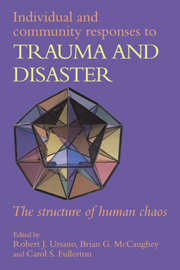Book contents
- Frontmatter
- Contents
- List of contributors
- Foreword
- Preface
- Part I Introduction
- Part II The nature of traumatic stress
- 2 The psychology of terror and its aftermath
- 3 Exposure to traumatic death: the nature of the stressor
- 4 Psychological and psychiatric aspects of technological disasters
- 5 Traumatic effects of accidents
- 6 The human experience of earthquakes
- 7 Psychological effects of toxic contamination
- Part III The role of psychosocial context in responses to trauma and disasters
- Part IV Responses to trauma across the life cycle
- Part V Conclusions
- Index
2 - The psychology of terror and its aftermath
from Part II - The nature of traumatic stress
Published online by Cambridge University Press: 13 October 2009
- Frontmatter
- Contents
- List of contributors
- Foreword
- Preface
- Part I Introduction
- Part II The nature of traumatic stress
- 2 The psychology of terror and its aftermath
- 3 Exposure to traumatic death: the nature of the stressor
- 4 Psychological and psychiatric aspects of technological disasters
- 5 Traumatic effects of accidents
- 6 The human experience of earthquakes
- 7 Psychological effects of toxic contamination
- Part III The role of psychosocial context in responses to trauma and disasters
- Part IV Responses to trauma across the life cycle
- Part V Conclusions
- Index
Summary
Traumatic events create terror – before, during, and after the trauma. This state of extreme fright is evoked by the experience of vulnerability, helplessness, loss of control, uncertainty, and threat to life. Often threats of violence are used to induce terror (Symonds, 1983). Recently, the world was reminded that terror is also induced in both individuals and groups by weapons, such as biological and chemical warfare, that cause shock, horror, helplessness, and panic. The psychological trauma of chemical and biological weapons is based on their capacity to contaminate and insidiously destroy an individual's sense of security and trust in the environment (Fullerton & Ursano, 1990). In Tel Aviv, Israel, 60 individuals sought emergency care after a SCUD missile explosion, thinking they had been exposed to chemical and biological warfare agents. No exposure had occurred but the terror of these weapons led them to a wrong belief. Soldiers in Saudi Arabia reportedly slept in their protective masks and gear for both protection and psychological comfort. In earlier wars when the threat of chemical and biological warfare was low protective gear had been rapidly discarded.
Terror is associated with human induced traumas: personal attacks, rapes, hostage takings, and terrorism to name a few. Violent crimes, in particular, affect millions of people each year. Thirty-seven million Americans were victims of crime in 1984 (Herrington, 1985); six million of these were victims of violent crime. Russell (1984, 1986) studied a random sample of 930 women.
- Type
- Chapter
- Information
- Individual and Community Responses to Trauma and DisasterThe Structure of Human Chaos, pp. 31 - 45Publisher: Cambridge University PressPrint publication year: 1994
- 16
- Cited by



